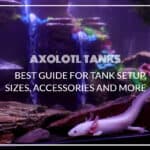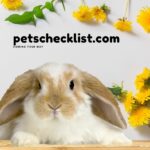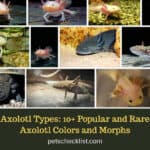The axolotl, a word pronounced as ‘ak-su,ló-t(u)l, is a fascinating creature of the class Amphibia. If you are familiar with the TV show Pokémon, seeing this creature may lead you to want to believe the show is real. But in reality, some of the Pokémon creatures are based on the actual amphibian animal. Now, what makes this amphibian salamander so fascinating? Let’s uncover more of this creature in this article and learn interesting facts about axolotls.

Table of Contents
What is an Axolotl? Quick Facts
| Popular Name | Axolotl, Mexican walking fish |
| Scientific Name | Ambystoma mexicanum |
| Adult Size | Between 15 and 23 cm long |
| Lifespan | 10 to 20 years on average |
Axolotls (Ambystoma mexicanum), also known as Mexican walking fish, are neotenic salamanders. They belong to the Ambystomatidae family. They have a rare trait of retaining their larval features throughout their adult life. It means that this creature is capable of reaching maturity without undergoing metamorphosis. They only display juvenile attributes after reaching adulthood. They are related to tiger salamanders but somehow recognized as the waterdogs.
Axolotls can reach an average length of 9 inches (20 centimeters), although some have reached over 12 inches (30 cm) longer. Based on a study, in captivity, the axolotls can live five to six years. Some have reached a maximum of seventeen years.
Axolotls are often in swamps, lakes, and canals. There are many wild axolotls in Lake Xochimilco, located in the southern part of Mexico City. You can also see them live in Lake Chalco, another of five great lakes of Mexico where former Aztecs settled. The carnivorous diet of Axolotls places them at the top of the food chain. Axolotls can catch mollusks, fish, and other arthropods and even eat each other. Axolotls are accustomed to being the main predators in their habitat. They began to suffer from the introduction of big fish into their habitat. Naturally occurring threats include predatory birds like herons.
Regeneration – The Most Bizarre Attribute of Axolotls
When it comes to having the highest regeneration capacity, the axolotls are considered to be the top vertebrate model system. For over 100 years, there have been studies that unraveled the cellular and molecular basis of axolotl regeneration attributes. These can be normally observed on their tissue and limb regrowth. Perhaps, the axolotls are the most studied animal among all salamanders.
“In the absence of a reference genome for the Axolotl, transcriptomic analysis becomes fundamental to understand the genetic basis of regeneration.” – Source
Are Axolotls Good Pets?

Many people with exotic preferences would like to bring an axolotl home. Axolotls can make good pets although they’re not your typical pet at all. They are rare but unique. The axolotls are fun to see with their different colors, including gold, white, gray, and black. They remain aquatic throughout their entire life. When they are at home, they stay inside an aquarium at the right temperature. It may not be your typical pet to handle, but they are entertaining to watch. If you are a beginner pet owner, axolotl suits for you.
You cannot resist the axolotls. They are, in fact, easy to care for and hardy. Their dietary routine is easy to understand. They have a great smile that is unusual to see to an amphibian. But behind those bright smiles are their aggressiveness when they are trying to catch their food. But after that, they typically walk around in the bottom of the aquarium and explore. In short, axolotls are peaceful pets.
Axolotl may even make a better pet than fish species. It is not necessary to change the water in the aquarium too often. The waste they made comes out in a big piece that can be recognized easily and removed immediately. You have to remember to remove the leftover food from the aquarium, as it may result in water contamination.
Axolotls in Captivity
Having an Axolotl in captivity is quite difficult than what you expected. Just like other pets, they need special attention too. Axolotl has demanding needs while living in captivity. They are a little sensitive in their environment. So, you should provide them a comfortable aquatic home to roam around. At first, you need to get them distilled and saltwater. Once they are used to it, you can mix it with your water at home. In their aquarium, place big but smooth rocks in the water. Do not even try to put small stones as axolotls can eat them. It may result in serious health problems, particularly in their digestive system.
In captivity, axolotls eat readily accessible feeds, including trout and salmon pellets, live or frozen blood worms, earthworms, and waxworms. Axolotls can also eat small fish, but be careful as the fish may contain pests. Feed them with a small portion throughout the day.
Substrates for Axolotl Aquariums
Substrates are also essential factors for captive axolotls, as axolotls tend to ingest bedding materials with food and are generally subject to gastrointestinal obstruction and ingestion of foreign matter. Some common substrates used in animal enclosures can be dangerous to amphibians and reptiles.
Based on laboratories’ study, intestinal obstruction is a common cause of their death. Strictly no items with a diameter measurement of below 3cm should be close to the axolotls. Based on experiments, axolotls might seek out proper size gravel for use as gastroliths. Therefore, it is not advisable to put gravel and small stones on aquariums when you want to keep axolotls.
Habitat and Ecology
Axolotls are members of the Tiger Salamander Complex or Ambystoma tigrinum and any other Mexican Ambystoma species. Their habitat is similar to most species, a high-elevation body of water surrounded by a potentially hazardous terrestrial environment. These conditions are deemed favorable. However, one terrestrial population that is known as Mexican tiger salamanders inhabits and breeds in axolotl’s habitat.
Axolotl originates solely from Lake Xochimilco and Lake Chalco in the Mexican Valley. Lake Xochimilco remains a relic of its old self, existing primarily as canals. The temperature of the water at Xochimilco rarely exceeds 20°C (68°F). Although it can fall to 6 to 7°C in winter, and possibly even decrease. While Lake Xochimilco is somehow in the right condition, Lake Chalco is no longer in existence.
There has been pressure on the wild population because of the growth of Mexico City. Axolotl is currently on the International Union for Conservation of Nature’s annual Red List of Species at Risk. Non-native fish, including Asian carp, have also recently been introduced into the waters. Those new fish ate the young axolotls, as well as their number one food source.
Lighting and Temperature for an Axolotl

Like other amphibians, axolotls do not require much lighting. They may be shy if they are kept under bright lighting and might hide in a designated place where they are comfortable to move. Some example of this place is aquarium furniture like woods, plants, caves, and other decorations. Lighting is for a great view of the aquarium and the axolotls. It also helps the plants and salamander inside regarding habitat supplies. Choose a bulb for a freshwater aquarium.
Axolotls prefer softened light. They have a defect vision, eyes without eyelids, and are sensitive to light. Regular interior lighting, without aquarium lighting, is enough. While the tank is light for the benefit of living aquatic plants, darker areas also need to be established.
Axolotls grow under cold temperatures. The range is from 15 to 18 degrees Celsius, so they won’t likely survive above 22 degrees Celsius. It can lead to heat stress, loss of appetite, and worst, death. If you can’t provide a proper place that meets the standard temperature of axolotls, they are not for you. To avoid overheating, never place axolotls in areas exposed to direct sunlight. During heat, get a wet towel as a cover in the tank with a fan blowing air through it.
What Foods Do Axolotls Eat?
If you are thinking of making an axolotl your pet one day, then be fully aware of the proper food with the right nutrients that they need to live the best as possible. Just like other animals, the axolotls require a strict but healthy diet as well. Axolotl food has three main categories; live foods, frozen foods, and pellets.
It is carnivorous, eating small prey such as insects, small wild fish, and worms. Axolotls locate their food by smelling it and get any potential meal – sucking food into their stomachs.
Young axolotls’ first perception of food is to lick and snap at anything alive and moving. Feed them live foods as early as possible. An adult axolotl is good with frozen foods and pellets. But before anything else, always wash your hands every time you begin to feed them.
Axolotls prefer live foods.
Live foods are the alive and moving species for young axolotls, live food such as nightcrawlers or red wiggler worms. You can purchase live worms in local pet shops. Ensure they are fresh and active. Grab a pair of tweezers to pick up a worm from the container. Make sure you properly wash off any of the excess dirt on the worm. This dirt can get an axolotl sick.
Frozen foods also work for them.
Frozen foods such as bloodworms are also available in pet stores. They tend to be the pet owner’s choice of food for their axolotls. It contains vitamins and proteins that will help your pet achieve its full development. To feed your pet, make sure to place the bloodworm in water. Use a pair of tongs to put it in front of your axolotls.
Pellets are good for them too.
Pellet food is the most convenient food that you can find in a local pet store. Before you purchase a pellet, make sure to check the back of the label for the ingredients. Pellet is high in protein and low in fat.
Reminder!
Feeding an axolotl all at once in one big meal may cause them major digestive problems. And in that case, you will need a specialized veterinarian to handle and take care of your axolotls.
Are Axolotls Dangerous?
Axolotls are not dangerous to humans. They are harmless creatures. These cute creatures only turn out to be vicious when they start to suspect other animal creatures in the aquarium trying to invade their territory. They will begin a fight by biting off their enemy’s body parts.
Their bites are not painful, so if you make them your pet, it is safe to touch this little creature. It will feel as though you have touched sandpaper or Velcro when they bite you but it is nowhere near to be considered painful. The only thing you have to worry about is that they may carry salmonella. But that is considered to be a rare case in axolotls. Salmonella causes stomachache, diarrhea, fever, and pain in the belly. A healthy axolotl is not dangerous at all unless they carry diseases that can affect humans.
If you love our content, we invite you to follow us on our social media outlets for more updates!

Hezekiah is a pet lover since birth, according to his parents. He started writing for the Pets Checklist in 2020. He is fond of playing with and taking pictures of different friendly animals around his neighborhood. He loves to read and write articles about pets, science, and music.













